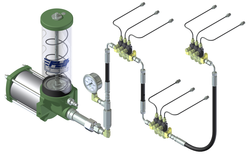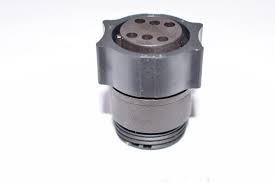
Central lubrication systems have revolutionized the maintenance and operation of machinery in various industries. These systems provide a constant supply of lubricant to different components of a machine, ensuring optimal performance and longevity. From heavy-duty manufacturing equipment to vehicles, central lubrication systems offer numerous advantages over traditional manual lubrication methods. This article explores the benefits and applications of central lubrication systems, shedding light on how they enhance efficiency, reduce downtime, and improve overall productivity in industrial settings. Understanding these advantages can help businesses make informed decisions about incorporating central lubrication systems into their operations for enhanced reliability and cost savings.
Isohitech Central Lubrication System is a cutting-edge and reliable solution designed to efficiently lubricate machinery and equipment in various industries. With precision engineering and advanced technology, the system ensures consistent and optimal lubrication, reducing friction and wear on critical components. It simplifies maintenance processes, extends equipment lifespan, and improves operational efficiency. The Isohitech Central Lubrication System offers customizable options to suit specific needs, providing automated lubrication at regular intervals, promoting smooth operation, and minimizing downtime. It is a cost-effective and user-friendly solution that enhances overall productivity and reliability in industrial applications.
What are central lubrication systems?
Central lubrication systems are mechanical systems that distribute lubricants automatically to various parts of a machine or equipment. They are designed to eliminate the need for manual lubrication, reducing maintenance time and increasing productivity. One advantage of central lubrication systems is that they ensure proper and consistent lubrication, which helps prevent wear and tear on moving parts. This not only extends the lifespan of the equipment but also reduces the risk of breakdowns and costly repairs.
Central lubrication systems find applications in various industries, including manufacturing, construction, mining, and transportation. They are commonly used in heavy machinery such as tractors, excavators, cranes, and conveyor belts. These systems can be customized to meet specific requirements based on factors like temperature, pressure, flow rate, and type of lubricant needed. By providing continuous lubrication to critical components of machines or equipment in harsh operating conditions or hard-to-reach areas, central lubrication systems contribute to improved performance, efficiency, and reliability.
Advantages of central lubrication systems
Central lubrication systems offer several advantages over manual lubrication methods. Firstly, they ensure consistent and precise lubrication to all the necessary components of a machine or equipment. This eliminates the potential for human error and ensures that each part receives the proper amount of lubricant at the right intervals, maximizing efficiency and prolonging the lifespan of the machinery.
Additionally, central lubrication systems help reduce downtime by minimizing maintenance requirements. With automated lubrication, machines can continue operating smoothly without interruptions for manual grease application. This not only saves time but also increases productivity and reduces costs associated with unplanned downtime.
Moreover, central lubrication systems contribute to improved workplace safety by reducing exposure to hazardous materials such as greases and oils. Employees no longer need to handle these substances directly during routine maintenance tasks, reducing their risk of accidents or health issues related to exposure.
Overall, central lubrication systems offer numerous advantages including improved accuracy in lubricant delivery, reduced downtime for maintenance, increased productivity, cost savings from fewer breakdowns, and enhanced workplace safety.
Increased equipment lifespan
One of the significant advantages of central lubrication systems is that they can significantly increase the lifespan of equipment. By ensuring that all moving parts are properly lubricated, these systems minimize friction and reduce wear and tear. As a result, the components last longer and require less frequent maintenance or replacement. This not only saves money on expensive equipment repairs but also minimizes downtime due to breakdowns.
Another key application of central lubrication systems is in heavy machinery and industrial equipment. These machines often operate under extreme conditions, such as high temperatures or heavy loads, which can accelerate wear on critical components. With a centralized system in place, operators can easily monitor and control the lubrication process for multiple machines simultaneously. This ensures that every part receives the right amount of lubricant at the right time, preventing premature failure and maximizing their lifespan.
In summary, central lubrication systems offer several advantages related to increased equipment lifespan. By reducing friction and minimizing wear on moving parts, these systems contribute to longer-lasting components and reduced maintenance needs. Furthermore, their application in heavy machinery allows for efficient monitoring and control of lubrication processes across multiple machines simultaneously, enhancing overall operational efficiency while extending equipment life expectancy.
Reduced maintenance costs
One of the key advantages of central lubrication systems is their ability to significantly reduce maintenance costs. By automating the lubrication process, these systems ensure that each component receives the right amount of lubricant at regular intervals, eliminating the risk of over or under-lubrication. This not only extends the lifespan of machine parts but also prevents costly breakdowns that can occur due to inadequate or improper lubrication.
With central lubrication systems, maintenance teams no longer have to manually lubricate each individual component, saving them valuable time and resources. The centralized nature of these systems allows for more efficient and effective maintenance practices, as technicians can easily monitor and control the entire lubrication process from a single location. This improves overall maintenance productivity and reduces labor costs associated with manual lubrication.
Additionally, central lubrication systems help minimize wastage by precisely delivering the required amount of lubricant to each component. This eliminates excess oil or grease buildup, which can lead to contamination and further maintenance issues. By reducing waste and optimizing lubricant usage, companies can reduce their overall spending on purchasing and disposing of excessive amounts of lubricants.
Improved equipment performance
Improved equipment performance is one of the key advantages and applications of central lubrication systems. These systems ensure that all moving parts within the equipment are properly lubricated, which reduces friction and wear. As a result, the equipment operates more smoothly and efficiently, leading to improved overall performance.
One way that central lubrication systems enhance equipment performance is by reducing downtime due to maintenance issues. When equipment is not adequately lubricated, it can experience increased wear and tear, leading to breakdowns and the need for frequent repairs. By consistently supplying lubricant to all the necessary components, central lubrication systems help prevent these issues from occurring, resulting in less downtime and increased productivity.
Furthermore, central lubrication systems also contribute to extended equipment lifespan. Proper lubrication reduces friction between moving parts, which minimizes wear on those parts over time. As a result, the equipment remains in better condition for longer periods before needing major repairs or replacement. This not only saves money on costly replacements but also ensures that the machinery continues to operate at optimal levels for an extended period of time.
Applications of central lubrication systems
Central lubrication systems have a wide range of applications across various industries. One such application is in the automotive industry, where these systems are used to ensure proper lubrication of critical components such as engines, transmissions, and suspension systems. By automatically delivering lubricant to these parts, central lubrication systems help prevent wear and tear, reduce friction, and extend the lifespan of these components.
Another important application of central lubrication systems is in heavy machinery and equipment. Industries such as construction, mining, and manufacturing heavily rely on large equipment that operates under extreme conditions. Centralized lubrication systems play a crucial role in ensuring the smooth functioning of these machines by providing continuous and precise lubrication to their different moving parts. This not only enhances the performance but also minimizes downtime due to maintenance issues caused by inadequate or improper lubrication.
In addition to automotive and heavy machinery applications, central lubrication systems are also widely used in other sectors like agriculture, marine, and railway industries. From tractors to ships to locomotives, these systems help maintain optimal operating conditions by delivering the right amount of lubricant at the right time. Overall, central lubrication systems offer numerous advantages across various industrial applications by improving efficiency, reducing maintenance costs, and enhancing equipment reliability.
Industrial machinery and equipment
One major advantage of central lubrication systems for industrial machinery and equipment is that they ensure consistent and proper lubrication. These systems are designed to automatically distribute the right amount of lubricant to each component, eliminating the need for manual greasing. This not only saves time and effort but also minimizes the risk of human error in lubrication, which can lead to equipment failure or breakdowns.
In addition to consistent lubrication, central lubrication systems also help extend the lifespan of industrial machinery and equipment. By providing a continuous supply of lubricant to all moving parts, these systems reduce friction and wear, which can significantly reduce maintenance costs. This is especially beneficial for heavy-duty applications where machinery operates under high loads or extreme conditions.
Central lubrication systems have a wide range of applications across various industries. They are commonly used in manufacturing plants, factories, construction sites, mining operations, and transportation fleets. Any industry that relies on large-scale machinery with numerous moving parts can benefit from these systems. From conveyor belts and pumps to cranes and excavators, central lubrication systems play a crucial role in ensuring smooth operation and maximizing productivity while minimizing downtime due to maintenance or repairs.
Automotive industry
Central lubrication systems play a crucial role in the automotive industry by ensuring proper lubrication of various mechanical components in vehicles. These systems offer several advantages that contribute to the smooth functioning and longevity of automotive machinery. Firstly, central lubrication systems eliminate the need for manual lubrication, saving both time and effort for automotive technicians. By automating the process, these systems ensure consistent and accurate application of lubricants to critical parts, reducing the risk of human error.
Moreover, central lubrication systems help improve overall vehicle performance by reducing friction and wear on important moving parts such as bearings and joints. Adequate lubrication prevents excessive heat generation and minimizes component failure, resulting in enhanced efficiency and extended equipment lifespan. In addition to this, these systems also contribute to noise reduction during vehicle operation by minimizing metal-to-metal contact that may cause squeaking or grinding sounds.
The applications of central lubrication systems are diverse across various sectors within the automotive industry. They are commonly used in heavy-duty vehicles like trucks and buses as well as construction machinery such as excavators and loaders. Moreover, these systems find their utility in manufacturing plants where conveyors, robots, and other automated equipment require continuous lubrication for optimal performance. With their ability to provide efficient lubrication even under extreme conditions or challenging environments, central lubrication systems have become an indispensable asset within the automotive industry.
